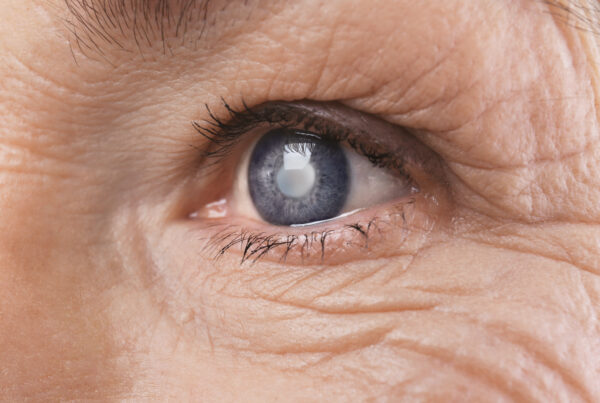
If you’re over the age of 40, there’s a good chance you’ve realized that your near vision “just isn’t what it used to be.” The loss of ability to focus on near objects is known as presbyopia. Presbyopia usually starts between the ages of 40-45, and is due to your eye muscles no longer being strong enough to squeeze and focus the lens inside your eye. So, if you’re beyond this age and not using reading glasses yet, congratulations, you must have some strong eye muscles!
When presbyopia begins to start, the first thing you might do to assist your eyes is to hold your reading material or cell phone a little bit farther away, which requires less focusing power than holding something closer. This is effective at first, but eventually your arms run out of length. The next step is typically over-the-counter reading glasses, or “cheaters.” These glasses are considerably cheaper (and safer!) than having a surgery to lengthen your arms to allow you to hold objects at a distance that you can still focus on. If you’re tired of constantly taking your glasses off and on, searching for them throughout your house, and having a pair in each room of your home and at your office, you’ll be glad to know that we offer several other options to meet your needs at SureVision Eye Centers.
The most common way we can improve your near vision is with lined bifocal or progressive prescription eyeglasses. You have likely seen your friends and family wearing bifocal glasses; these glasses have your distance prescription in the top part of the lens, where your eyes look through when you look straight ahead. The bottom of the lens has a line, and below this line is a small segment of a second lens that has the power you need to see up close.
Lined bifocal glasses are typically very easy to get used to, but some patients don’t like the look of the line on their glasses lenses. To get rid of the lined bifocal, you could be prescribed a progressive lens instead. A progressive lens is also called a “no-line bifocal,” because it still allows you to focus at distance and near like a bifocal, but there is a smooth transition between the distance and near power which eliminates the line. In addition to the cosmetic benefit of not having a line on your glasses lens, another benefit of a progressive is that it also has an area of the lens to allow you to focus on objects at an intermediate distance, such as your computer screen.
Contact lenses are another great option to allow you to focus at distance and near without the need for reading glasses. There are two main contact lens options to correct your near vision: multifocal and monovision. Multifocal lenses help you to see clearly at all distances, while allowing both eyes to work together as they naturally do. While multifocal contact lenses are great, they do require your eyes to adapt to the lenses, which sometimes is easier said than done.
If you are not a candidate for multifocal lenses, you could benefit from monovision contacts. Monovision means that you are using one eye at a time. At your initial contact lens evaluation, we will determine which eye is your dominant eye, and this eye will be focused to see far away. Your non-dominant eye will be fit with a contact lens that focuses on objects up close. Just like multifocal contact lenses, this option requires an adaptation period; if you are able to adapt to using one eye at a time, this option can provide you with clear, comfortable vision and eliminate your need for reading glasses.
If you read the part about the arm surgery earlier and wished that there was actually a surgical option for you, you’re in luck! SureVision Eye Centers offers a surgery known as Refractive Lens Exchange, or RLE. RLE is very similar to cataract surgery, but for patients who have not yet developed cataracts, or cloudiness of the natural lens inside your eye.
During RLE, your natural lens is removed, and it is replaced by an artificial lens. Just like contact lenses, this lens can be a multifocal lens to provide you with a range of clear vision from distance to near. This lens is calculated to be the precise power you personally need to see far away and get rid of your distance glasses, while also being able to focus on objects up close, such as a book, computer, or phone.
If you’re a monovision contact lens patient, have you ever wished that you could wake up with monovision without having to put your contacts in? Well, you can! Monovision lens implants can be done with RLE, reducing your need for distance and reading glasses. Another added benefit of RLE is that the artificial lens implant will never “go bad,” and you will never develop cataracts later in life.
The newest option for near vision correction is a prescription eye drop called Vuity. This drop activates the muscles of your iris, or the colored part of your eye, to make your pupil smaller. This increases the range of distances that you are able to focus on and see clearly. This option is not a permanent fix; you have to use the drop each day that you want to leave your reading glasses behind, and the effect typically lasts between 6 to 8 hours. To find out if you are a candidate for this new eye drop, you would first need to schedule a comprehensive eye exam to make sure you do not have any eye conditions that would make it unsafe for you to use the medication.
At SureVision Eye Centers, we are proud to offer you a range of options to meet your visual needs. To determine which option is best for you, schedule an appointment with one of our eye doctors.



